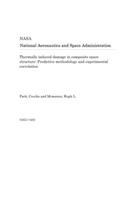
Thermally Induced Damage in Composite Space Structure
Series:
A general analysis method is presented to predict matrix cracks in all plies of a composite laminate, and resulting degraded laminate properties, as functions of temperature or thermal cycles. A shear lag solution of the stresses in the vicinity of cracks and a fracture mechanics crack formation criteria are used to predict cracks. Damage is modeled incrementally, which allows the inclusion of the
NaN
VOLUME
English
Paperback

A general analysis method is presented to predict matrix cracks in all plies of a composite laminate, and resulting degraded laminate properties, as functions of temperature or thermal cycles. A shear lag solution of the stresses in the vicinity of cracks and a fracture mechanics crack formation criteria are used to predict cracks. Damage is modeled incrementally, which allows the inclusion of the effects of temperature dependent material properties and softening of the laminate due to previous cracking. The analysis is incorporated into an easy-to-use computer program. The analysis is correlated with experimentally measured crack densities in a variety of laminates exposed to monotonically decreasing temperatures. Crack densities are measured at the edges of specimens by microscopic inspection, and throughout the specimen volumes by x-ray and sanding down of the edges. Correlation between the analytical results and the crack densities in the interiors of the specimens was quite good. Crack densities measured at specimen edges did not agree with internal crack densities (or analyses) in some cases. A free-edge stress analysis clarified the reasons for these discrepancies. Park, Cecelia and Mcmanus, Hugh L. Unspecified Center NAG1-1463...
Price Comparison [India]
In This Series
Bestseller Manga
Trending NEWS




















